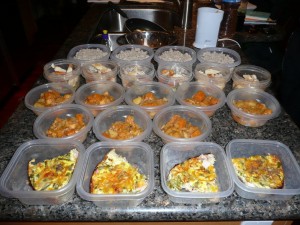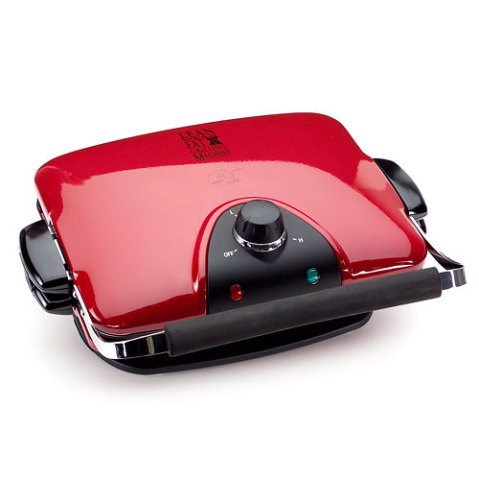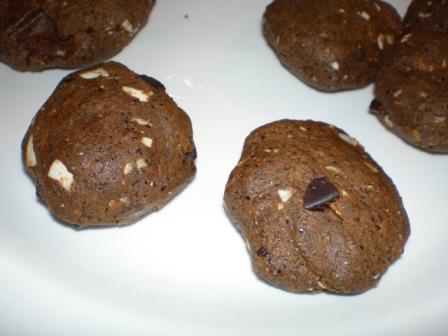Why eating well on the go is so important
If we could come up with the perfect nutrition plan for you that included exactly what you needed to eat to reach your goals, you wouldn’t follow it.
Don’t believe us? How often have you seen people diagnosed with lifestyle related disease who don’t take the necessary steps to improve their situation? They say they want to “eat better.” They see health professionals who tell them how to “eat better.” Yet they end up feeling guilty for not “eating better.”
Why is it so hard for them to make the change?
Well, unless they really don’t want to change, there are two major obstacles.
Roadblock #1: Habits
These are ingrained set of day to day food and activity related actions. These are often sub-optimal since people might not have a conscious, logical plan for changing them.
Roadblock #2: Tough times
Things might be getting better; then the tough times hit. People “get busy.” Eating well becomes inconvenient. No one else supports their decision to make a change. When these inevitable circumstances come up, they bail.
Look at the three most frequently reported reasons for eating fast-food:
- It’s quick
- It’s easy to get
- It tastes good
What does this tell us? When the going gets tough, people get going to Burger King.
Advertising and societal norms have a powerful influence. People often go to fast food because they don’t consider other options. They see commercials for fast food, their parents eat it, their friends eat it, their co-workers eat it, and so on. It’s what people do (well, it’s what non-fit people do).
A major battle in the fight for a lean and healthy body is having nutritious food ready and available. Even if you know what’s healthy, if you aren’t prepared when it’s time to eat, you’re doomed.
With that being said, what can you do? You can plan for the unplanned.
What you should know about eating on the go
How can you “plan for the unplanned” and have healthy food ready to eat?
A few different ways, actually. Each depends on your willingness, time management, money management, and overall goals.
Eating on the Go Option #1: Weekly ritual
Imagine this: Every time you are hungry and ready to eat, you flip open a cooler and take out a container of a tasty, nutritious food. Gosh, healthy nutrition would be fool-proof, right? If that sounds good, then introduce yourself to the “Weekly Ritual.”
The “Weekly Ritual” is commonly referred to as the Sunday ritual in the PN world. You pick one day per week, set aside a few hours, plan your food intake, buy the foods, and prepare the foods.
This will take time, but remember, you get out what you put in. Things that are worthwhile (in nutrition and in life) take time and effort.
While Sunday is a popular day for this, any day will work. Let us warn you, at first, your friends and family may dismiss this new habit as “extremist.” They might insist that you’ve lost your mind and joined a food preparation cult. While certain situations do call for a more relaxed approach to eating (lugging your lunch pail into a restaurant with colleagues for a job interview isn’t very cool), having nutritious eats for the week is generally what fit people do.
Below: A PN client’s food prepped and packed for the week
 |
 |
Eating on the Go Option #2: Daily Ritual
So you don’t like the weekly gig, huh? No problem.
How about a daily food prep ritual? In less than 30 minutes, you can get all of your food organized for the day (or the following day). This can be as easy as heading to your local market before/after your day begins and loading up a big container (or 2) at the salad bar with the food you need.
Not that hardcore? Then how about setting the alarm 30 minutes earlier each day and doing a breakfast ritual. It’s a mini version of the weekly ritual. Just gather up the food you have on hand and prep your meals for the day. Steam some veggies, cut some fruit, mix some beans, cook some grains, etc. Just do this while you’re prepping meal #1 for the day. You’re going to do that anyways, right?
Don’t go knucklehead and get yourself sick. Have a cooler, ice packs, and quality containers to preserve your nutritious food stash. Also, other basic kitchen gear like a countertop grill can be handy. See our All About Kitchen Makeovers article for more on this.

Eating on the Go Option #3: If your religion doesn’t allow rituals, have others do it
Maybe there’s some other reason you’re prevented from doing these regular rituals. If your lifestyle allows, you could hire someone to prepare your food for the week, or get all of your food from a healthy market that does the preparation. You could even investigate a local restaurant that delivers. Even standard grocery stores have plenty of options for the time crunched.
The “having no time” excuse is, well, rationalization taking over. Sorry.
Having others preparing your food can seem extravagant to some people, and we’ll accept that. But for those weeks when you are extremely busy, finding a healthy grocery store, restaurant or food preparation service to do the prep for you can add years and quality to your life. Swing by Whole Foods and get 10 pre-made deli salads for lunch and dinner, a bunch of pre-cut and pre-washed veggies, fruits, pre-made hummus, and raw nuts for snacks. Just mix in a super shake for breakfast and you’re set.

For extra credit
The restaurant lunch
Maybe it’s for business, maybe it’s for school, maybe it’s a date, and maybe it’s alone. Doesn’t matter. The last minute restaurant lunch request will likely occur at some point.
A nutritious selection is simple. Focus on veggies. Mix in some lean protein and whole grains if desired. Add a bit of healthy fat. Order items steamed and dry with sauce and dressing on the side. Don’t eat until you’re stuffed. There you have it. Years of nutrition education summarized in less than 40 words.
When menu-scanning, you can use several strategies:
- Look for protein. Is there: grilled chicken breast, lean beef, shrimp tuna, beans, etc.? Start with that and figure out how to add veggies to it — you can usually request a substitution (such as a side salad instead of fries).
- Look for veggies. Is there a salad? Veggies and dip? Start with that and figure out how to add protein to it — you can often get chicken breast etc. on top of a salad.
- Look at side dishes. Often you can assemble a pretty good meal from a few side orders, such as a single egg or a cup of fruit.
- Look at the appetizer menu. If you’re in North America, it’s a safe bet to assume portions will be big. Try ordering a small item or two instead of a table-crushing platter of ribs.
- Soup and salad are filling, and most restaurants offer some variation on this theme.
Build a repertoire of restaurants that you know offer healthy choices. Keep that list of options in your back pocket as a ready response to “Oh I don’t know, where would you like to go?”
Road trips
Scope the scene
When I travel, the first thing I do is scope out the location around where I’m staying. What natural markets are nearby? Any healthy cafes? Any fast food restaurants I can make fun of? We have this tool known as the internet, you can use it for this kind of research. Check out what “grocery stores near [hotel address]” turns up on Google Maps.
Let me upgrade you
While I’ve stayed in my share of “Bates Motel” style rooms, it’s always well worth it when I upgrade to a room with a mini kitchen and food storage area. That way, at least I can prep one meal in the room and save cash. Those mini-fridges are great, you can store 6-packs of beer…errr…veggies and fruit, use the microwave for oatmeal, and the coffee maker can heat water for green tea. Bonus.
Depending on where you’re going, you can also look into a suite-style hotel room or even a condo or apartment (if you’re staying for a few days or more). Extended stay-type hotels are usually comparably priced and offer a pretty decent kitchen setup that might even beat your one-bedroom apartment.
The unhealthy skies
Guess what? Planes don’t have healthy food, nor should they. Planes have other things to worry about, like being safe flying machines.
The good news is that bringing a cooler or bag of veggies, fruit and nuts for the travel day is easy and tasty.
Protein bars
If you buy nutrition bars at a store, I have some cutting edge advice – check the ingredients. If it has something you wouldn’t find in your own kitchen, don’t buy it.
Homemade bars are a better option, if you can manage them. GN and PN have excellent recipes.
You can even try savoury tempeh bars: Marinate a hunk of tempeh, bake or roast it, cut it into bars, and throw it into ziploc bags. It’ll keep unrefrigerated for at least a day of traveling.
We’ve also been in the kitchen experimenting with more ideas:
The Near Perfect Bar
½ cup organic molasses or agave nectar (may need slightly less is you use agave – only use molasses if you LIKE the flavor)
½ cup organic (raw if possible) nut or seed butter (e.g., hemp seed, peanut, cashew, almond, macadamia, etc.)
¾ to 1 cup vanilla or unflavored protein powder
¾ to 1 cup organic dried cranberries, diced dates, diced figs, raisins, dark chocolate chips, cocoa nibs, goji berries (pick your favorite, or mix some together)
½ cup organic shredded coconut
2 tsp of greens powder if you are feeling daring
Work all ingredients together, adding the protein powder in small batches so the mixture is firm but not crumbly. Shape into the size and number of bars you prefer. Chill in fridge or freezer.

Other options
Dried fruits and veggies will work for traveling too. There are freeze dried versions that won’t go rancid and are a huge step up from standard vending machine fare. You can get roasted legumes, like chickpeas, for a snack as well. Powdered greens supplements count; you can add them to shakes with this powdery drink mix known as protein powder.
Jerky is fine – you can find jerky made from soy, seitan, ostrich, salmon, and anything in between. (And if you’re in Sedona, Arizona, be sure to visit Buck Thornton’s World of Jerky!) Or what the heck, make your own.
Summary and recommendations
Eating healthy can be difficult. But it can also be quite easy. If having healthy food on hand is holding you back, try incorporating a food preparation ritual. See how it works for you. If once a week is overwhelming, try a daily ritual. If you aren’t willing to invest the time and energy into your own food prep, try outsourcing. Your body will thank you.
A bit of planning ahead goes a long way.
If you frequently travel, pack a bag of veggies, fruit, nuts/seeds, along with nutrition bars, protein powder and jerky to keep you fueled.
References
Click here to view the information sources referenced in this article.
Learn more
Want to get in the best shape of your life, and stay that way for good? Check out the following 5-day body transformation courses.
The best part? They're totally free.
To check out the free courses, just click one of the links below.




Share